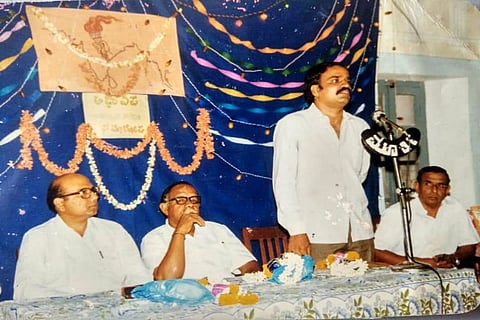

It was a turbulent time in Karnataka in 1994 as communal clashes were threatening to erupt over the Idgah Maidan issue in Hubballi.
The dispute was between Anjuman-e-Islam (an educational institution) and the Hubballi-Dharwad Corporation over the ownership of the Idgah Maidan. On Independence Day in 1992, a Sangh Parivar affiliated outfit – Rashtradhvaja Gowrava Samrakshana Samiti tried to hoist the national flag in Idgah Maida but was stopped. In 1994, Uma Bharati of the BJP tried to hoist the national flag at the maidan. The members of the outfit were stopped. The issue spiralled into a larger communal conflict where six people were killed in police firing.
For the BJP, which had struggled to get its candidates elected at that point, this issue became a turning point for the party’s rise in Karnataka. And Ananth Kumar, who passed away on Monday at 59, became one of the master strategists credited with the rise of the BJP in the state.
By 1994, Ananth Kumar had already risen to the rank of General Secretary of the BJP in Karnataka. An apprentice of veteran LK Advani, Ananth Kumar, who was a native of Hubballi, took the opportunity to spread the BJP’s influence.
“With Veerendra Patil being ousted by Rajiv Gandhi as Karnataka CM in 1990, there was unrest among Lingayats. This gave Ananth Kumar the idea to mobilise Lingayat votes. He managed to spread the RSS' influence across north Karnataka. But he saw a larger opportunity to turn the votes against the Congress and Janata Party after the Idgah Maidan conflict. In 1994, Veerappa Moily was the Chief Minister of Karnataka. Ananth Kumar sketched a master plan. He conceptualised the “Moily Hatao” campaign after the conflict broke out,” a BJP leader said.
With LK Advani calling for Moily’s removal as Chief Minister of Karnataka and Ananth Kumar doing the leg work to turn the voters of North Karnataka, the BJP made massive gains in the 1994 Assembly Elections.
Just five years prior to that, the BJP had won only four seats in the Assembly. With this master stroke, the BJP managed to win 40 seats in 1994. Ananth Kumar helped construct a narrative to mobilise Hindu votes after the clashes in August 1994 and north Karnataka has been a BJP bastion ever since.
“Ananth Kumar was born and raised in Hubballi. He knew the mindset of the people in his hometown. With his excellent oratory skills and his sharp mind, he managed to spread the influence of the BJP and RSS,” the BJP leader added.
Son of Narayana Shastri, an engineer in the Railways, and Lalitha Shastry, who was once the Deputy Mayor of Hubballi-Dharwad City Corporation, the late Union Minister Ananth Kumar’s interest in politics began at a young age of 16.
Inspired by the speeches given by Jaya Prakash Narayan during the Emergency, Ananth Kumar joined the Akhila Bharatiya Vidhyarti Parishad (ABVP) in 1975.
With his penchant for organising protests and rallies, Ananth Kumar became an invaluable asset to the ABVP. Veterans in Karnataka politics say that Ananth Kumar was one of the key players in the rise of RSS and the ABVP in Karnataka, a state where the BJP had fared poorly in the 1970s and 1980s.
With the party having a negligent presence in Karnataka, the RSS decided to send Ananth Kumar to the BJP, with hopes of spreading the party’s influence. He joined the BJP in 1987 and was appointed the state secretary and also the state president of the BJP Yuva Morcha.
In 1988, he was appointed the general secretary of BJP. With only a year left for the elections, Ananth Kumar’s hands were tied and the BJP did not make any gains in the 1989 elections. This was a time when the Janata Party and the Indian National Congress ruled the roost in Karnataka with former CM Veerendra Patil, a prominent Lingayat leader, at the helm of state politics.
In the 1989 elections, the BJP won just four seats in Karnataka. This did not deter Ananth Kumar. With BS Yeddyurappa playing the role of mentor to Ananth Kumar, the duo became formidable and is credited for turning the BJP’s fortunes around in the state.
Ananth Kumar travelled across the length and breadth of Karnataka along with Yeddyurappa and built up a strong base for the party, especially in North Karnataka.
By proving his ability to deliver after the 1994 elections, Ananth Kumar became one of the few leaders to obtain a ticket to contest the Lok Sabha polls without having to contests state elections. In 1996, with absolutely no experience as a legislator, Ananth Kumar defeated former CM’s wife Varalakshmi Gundu Rao and became BJP’s leader with a success streak to follow.